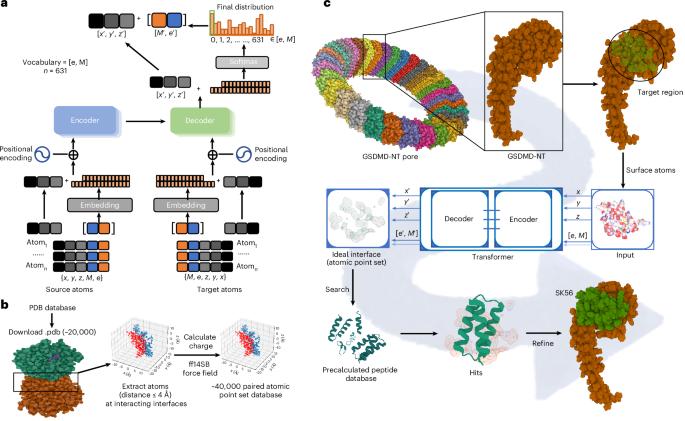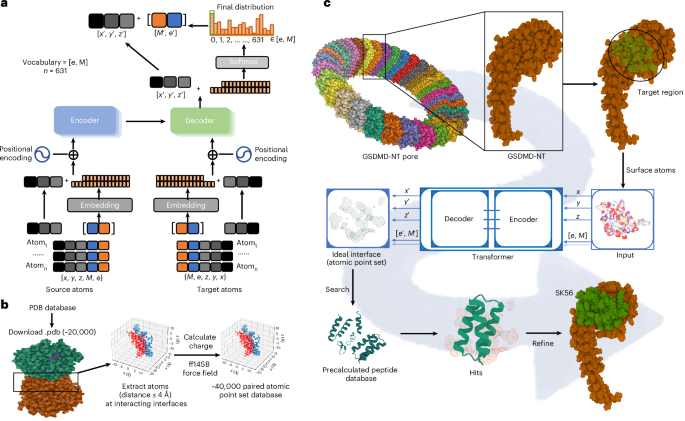Delaying pyroptosis with an AI-screened gasdermin D pore blocker mitigates inflammatory response
IF 27.6
1区 医学
Q1 IMMUNOLOGY
引用次数: 0
Abstract
The formation of membrane pores by cleaved N-terminal gasdermin D (GSDMD-NT) results in the release of cytokines and inflammatory cell death, known as pyroptosis. Blocking GSDMD-NT pores is an attractive and promising strategy for mitigating inflammation. Here we demonstrate that SK56, an artificial intelligence-screened peptide, effectively obstructs GSDMD-NT pores and inhibits pyroptosis and cytokine release in macrophages and human peripheral blood leukocyte-induced pyroptosis. SK56 prevents septic death induced by lipopolysaccharide or cecal ligation and puncture surgery in mice. SK56 does not influence cleavage of interleukin-1β or GSDMD. Instead, SK56 inhibits the release of cytokines from pyroptotic macrophages, mitigates the activation of primary mouse dendritic cells triggered by incubation with pyroptotic cytomembranes and prevents widespread cell death of human alveolar organoids in an organoid–macrophage coculture model. SK56 blocks GSDMD-NT pores on lipid-bilayer nanoparticles and enters pyroptotic macrophages to inhibit mitochondrial damage. SK56 presents new therapeutic possibilities for counteracting inflammation, which is implicated in numerous diseases. Wang and colleagues show that an AI-assisted designed peptide obstructs GSDMD pores and inhibits IL-1β and IL-18 release and pyroptosis.


用ai筛选的气皮蛋白D孔阻滞剂延缓焦亡可减轻炎症反应
裂解的n端气皮蛋白D (GSDMD-NT)形成膜孔,导致细胞因子的释放和炎症细胞死亡,称为焦亡。阻断GSDMD-NT毛孔是一种有吸引力和有前途的减轻炎症的策略。在这里,我们证明了人工智能筛选的肽SK56可以有效地阻断GSDMD-NT孔,抑制巨噬细胞和人外周血白细胞诱导的焦亡和细胞因子释放。SK56可预防脂多糖或盲肠结扎和穿刺手术引起的小鼠脓毒性死亡。SK56不影响白细胞介素-1β或GSDMD的切割。相反,在类器官-巨噬细胞共培养模型中,SK56抑制热噬巨噬细胞细胞因子的释放,减轻由热噬细胞膜孵养引发的小鼠原代树突状细胞的活化,并防止人肺泡类器官的广泛细胞死亡。SK56阻断脂质双层纳米颗粒上的GSDMD-NT孔,进入热噬细胞,抑制线粒体损伤。SK56为对抗炎症提供了新的治疗可能性,炎症与许多疾病有关。
本文章由计算机程序翻译,如有差异,请以英文原文为准。
求助全文
约1分钟内获得全文
求助全文
来源期刊

Nature Immunology
医学-免疫学
CiteScore
40.00
自引率
2.30%
发文量
248
审稿时长
4-8 weeks
期刊介绍:
Nature Immunology is a monthly journal that publishes the highest quality research in all areas of immunology. The editorial decisions are made by a team of full-time professional editors. The journal prioritizes work that provides translational and/or fundamental insight into the workings of the immune system. It covers a wide range of topics including innate immunity and inflammation, development, immune receptors, signaling and apoptosis, antigen presentation, gene regulation and recombination, cellular and systemic immunity, vaccines, immune tolerance, autoimmunity, tumor immunology, and microbial immunopathology. In addition to publishing significant original research, Nature Immunology also includes comments, News and Views, research highlights, matters arising from readers, and reviews of the literature. The journal serves as a major conduit of top-quality information for the immunology community.
 求助内容:
求助内容: 应助结果提醒方式:
应助结果提醒方式:


